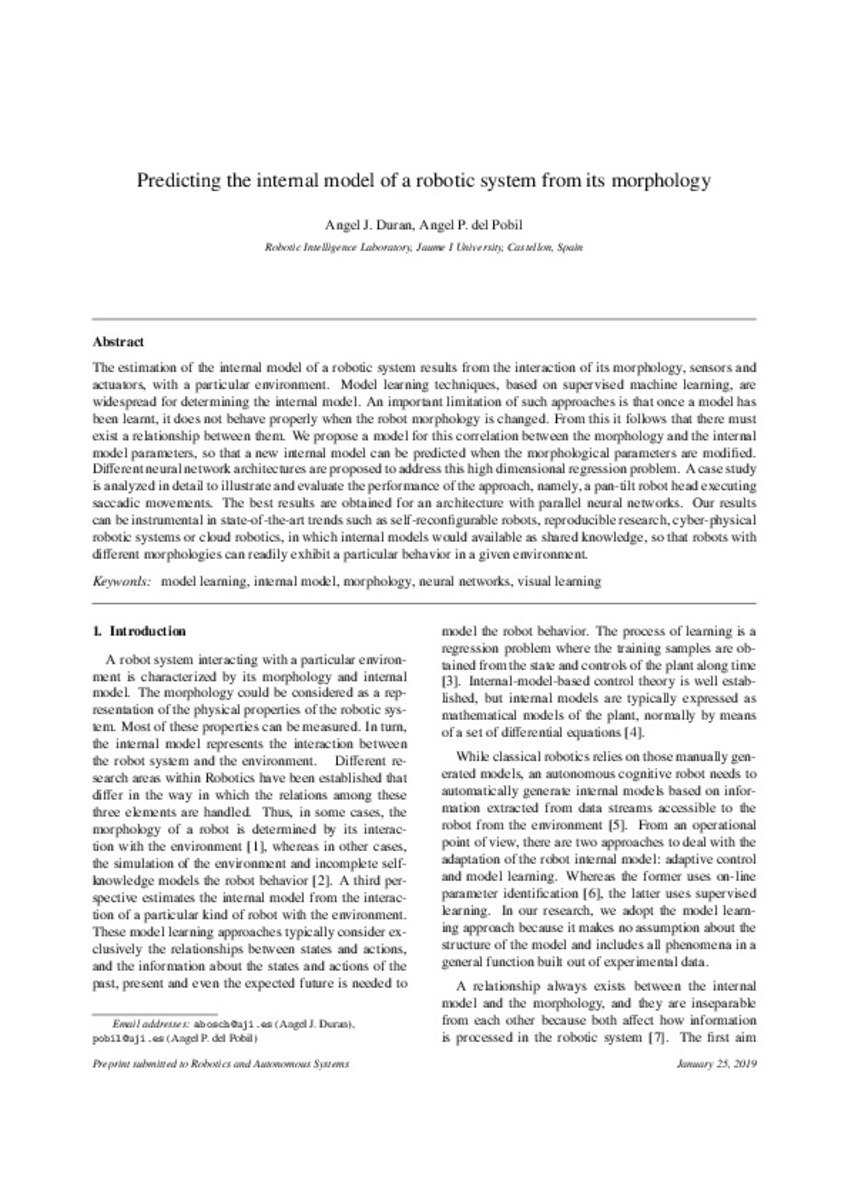Mostrar el registro sencillo del ítem
Predicting the internal model of a robotic system from its morphology
| dc.contributor.author | Durán Bosch, Angel Juan | |
| dc.contributor.author | del Pobil, Angel P. | |
| dc.date.accessioned | 2019-02-06T15:39:04Z | |
| dc.date.available | 2019-02-06T15:39:04Z | |
| dc.date.issued | 2018 | |
| dc.identifier.citation | DURAN, Angel J.; DEL POBIL, Angel P. Predicting the internal model of a robotic system from its morphology. Robotics and Autonomous Systems, 2018, vol. 110: 33-43 | ca_CA |
| dc.identifier.issn | 0921-8890 | |
| dc.identifier.uri | http://hdl.handle.net/10234/180786 | |
| dc.description.abstract | The estimation of the internal model of a robotic system results from the interaction of its morphology, sensors and actuators, with a particular environment. Model learning techniques, based on supervised machine learning, are widespread for determining the internal model. An important limitation of such approaches is that once a model has been learnt, it does not behave properly when the robot morphology is changed. From this it follows that there must exist a relationship between them. We propose a model for this correlation between the morphology and the internal model parameters, so that a new internal model can be predicted when the morphological parameters are modified. Di erent neural network architectures are proposed to address this high dimensional regression problem. A case study is analyzed in detail to illustrate and evaluate the performance of the approach, namely, a pan-tilt robot head executing saccadic movements. The best results are obtained for an architecture with parallel neural networks due to the independence of its outputs. Theses results can have a great significance since the predicted parameters can dramatically speed up the adaptation process following a change in morphology | ca_CA |
| dc.format.extent | 13 p. | ca_CA |
| dc.format.mimetype | application/pdf | ca_CA |
| dc.language.iso | eng | ca_CA |
| dc.publisher | Elsevier | ca_CA |
| dc.relation.isPartOf | Robotics and Autonomous Systems, 2018, vol. 110: 33-43 | ca_CA |
| dc.rights | Attribution-NonCommercial-NoDerivatives 4.0 Internacional | |
| dc.rights | Author's post-print must be released with a Creative Commons Attribution Non-Commercial No Derivatives License. | |
| dc.rights.uri | http://creativecommons.org/licenses/by-nc-nd/4.0/ | |
| dc.subject | model learning | ca_CA |
| dc.subject | internal model | ca_CA |
| dc.subject | morphology | ca_CA |
| dc.subject | neural networks | ca_CA |
| dc.subject | visual learning | ca_CA |
| dc.title | Predicting the internal model of a robotic system from its morphology | ca_CA |
| dc.type | info:eu-repo/semantics/article | ca_CA |
| dc.identifier.doi | https://doi.org/10.1016/j.robot.2018.08.014 | |
| dc.relation.projectID | This paper describes research done at the UJI Robotic Intelligence Laboratory. Support for this laboratory is provided in part by Ministerio de Economa y Competitividad (DPI2015-69041-R), by Fondo Europeo de Desarrollo Regional (FEDER), by Generalitat Valenciana (PROMETEOII/2014/028) and by Universitat Jaume I (P1-1B2014-52, PREDOC/2013/06). | ca_CA |
| dc.rights.accessRights | info:eu-repo/semantics/openAccess | ca_CA |
| dc.relation.publisherVersion | https://www.sciencedirect.com/science/article/pii/S0921889017306942 | ca_CA |
| dc.type.version | info:eu-repo/semantics/submittedVersion | ca_CA |
Ficheros en el ítem
Este ítem aparece en la(s) siguiente(s) colección(ones)
-
ICC_Articles [414]








